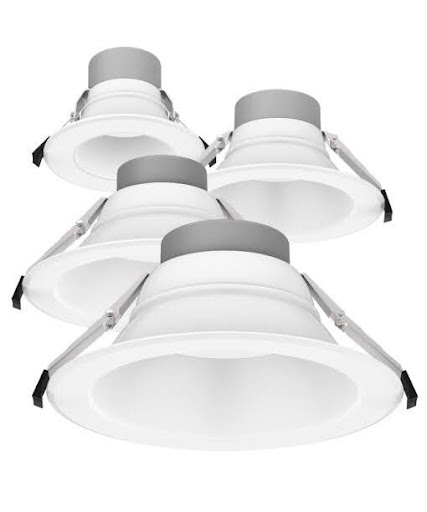LED commercial light fixtures are a cutting-edge solution for modern business lighting needs. These fixtures deliver bright, consistent illumination while consuming considerably less energy than traditional lighting options, leading to significant electricity cost savings. Their longevity reduces the frequency of replacements and maintenance, further lowering overall expenses. Designed to withstand the demands of commercial environments, LED fixtures offer durability and reliability. They are available in various styles and configurations, making them versatile for different settings such as offices, retail stores, and warehouses.
Additionally, many LED fixtures come with adjustable features and different color temperatures, allowing businesses to customize the lighting to enhance productivity and create the desired ambiance. Choosing the right LED commercial light fixtures is crucial for any business aiming to create a well-lit, efficient, and visually appealing workspace. The lighting quality impacts your commercial space’s aesthetics, productivity, safety, and energy consumption. This comprehensive guide will walk you through the key factors to consider when selecting LED commercial light fixtures for your business.
Evaluate Fixture Types and Styles
LED commercial light fixtures come in various types and styles, each suited for different applications. Here are some common options:
- Panel Lights are ideal for drop ceilings and provide uniform lighting. Due to their sleek design and high efficiency, they are commonly used in offices and schools.
- High-Bay Lights: Designed for high-ceiling spaces like warehouses and manufacturing facilities. They offer powerful illumination and are often used to cover large areas.
- Downlights: These fixtures are recessed into the ceiling, providing direct, focused light. Retail and office environments often use them for a clean, modern look.
- Flood Lights are suitable for outdoor or large indoor spaces with high-intensity lighting. They are commonly used for security or illuminating large areas.
Consider Energy Efficiency and Cost
One of the major advantages of LED lighting is its energy efficiency. LEDs consume less power than traditional lighting sources like incandescent or fluorescent bulbs. When selecting LED fixtures, look for:
- Luminous Efficacy: This measures how effectively a light fixture converts electricity into light. Higher efficacy means more light per watt of energy consumed. Choose fixtures with high luminous efficacy to maximize energy savings.
- Energy Star Certification: Fixtures with Energy Star certification meet specific energy efficiency criteria and performance standards. They are a good indicator of high efficiency and can help reduce long-term energy costs.
- Initial Cost vs. Long-Term Savings: LED fixtures may have a higher upfront cost, but they often result in significant savings over time due to lower energy consumption and longer lifespans. Evaluate the total cost of ownership to make a cost-effective decision.
Assess Light Quality and Performance
The quality of light produced by LED fixtures can vary. Consider the following factors to ensure optimal lighting performance:
- Color Temperature: Measured in Kelvin (K), color temperature affects the ambiance of your space. Choose fixtures with a lower color temperature (2700K to 3000K) for a warm, inviting atmosphere. Opt for a cooler, more energetic environment with higher color temperatures (4000K to 5000K).
- Color Rendering Index (CRI): CRI measures how accurately a light source renders colors compared to natural light. A higher CRI (90 or above) is ideal for areas where color accuracy is important, such as in retail environments or art galleries.
- Dimmability: Some LED fixtures offer dimming capabilities, allowing you to adjust light levels according to your needs. This can enhance flexibility and energy savings, particularly in spaces where lighting needs vary throughout the day.
Installation and Maintenance Considerations
Proper installation and maintenance are crucial for the longevity and performance of LED fixtures:
- Ease of Installation: Choose fixtures that are compatible with your existing infrastructure and are easy to install. Some LED fixtures come with mounting kits and instructions to simplify the process.
- Maintenance Requirements: LEDs generally require less maintenance than traditional lighting. However, consider the accessibility of fixtures for any future maintenance or bulb replacement needs. Fixtures with long lifespans and durable designs can further reduce maintenance efforts.
Environmental and Safety Standards
LED fixtures should comply with environmental and safety standards to ensure their suitability for commercial use:
- Environmental Impact: LEDs are more environmentally friendly than traditional lighting options due to their lower energy consumption and lack of hazardous materials. Verify that the fixtures you choose are free from mercury and other harmful substances.
- Safety Certifications: Look for fixtures with certifications such as UL (Underwriters Laboratories) or CE (Conformité Européenne). These certifications ensure that the fixtures meet safety and quality standards.
Conclusion
Selecting the right LED commercial light fixtures involves determining fixture types, energy efficiency, light quality, installation requirements, and environmental considerations. By understanding these factors and choosing fixtures that align with your business goals, you can enhance the functionality and aesthetics of your commercial space while benefiting from long-term energy and cost savings.
Investing time in choosing the right LED fixtures will not only improve the lighting quality but also contribute to a more productive and visually appealing environment for your employees and customers.

